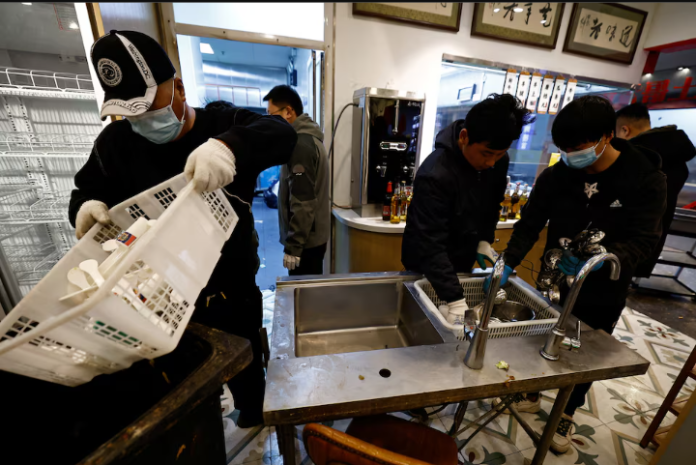In the heart of Beijing, amid stacks of industrial kitchen equipment, businessman An Dawei surveys the remnants of shuttered restaurants—giant fridges, commercial ovens, and industrial stoves waiting to be resold. His business, which thrives on dismantling failed eateries, has never been busier.
“For most people, opening a restaurant now is almost a guaranteed failure,” An says. His experience reflects a grim reality: China’s restaurant industry is in crisis, driven by deflation, shrinking consumer spending, and an unforgiving price war.
A Harsh Reality: Mass Restaurant Closures
The numbers paint a stark picture. In 2024, nearly 3 million restaurants across China closed their doors—an unprecedented wave of failures. Data from Qichacha, a business registry, shows that restaurant closures in major cities like Beijing, Shanghai, Guangzhou, and Shenzhen exceed 10% per month, sometimes reaching as high as 15%.
The reasons are clear. Many entrepreneurs had hoped for a V-shaped economic recovery post-COVID, only to be met with plunging consumer confidence and deflationary pressure. February 2025 saw China’s consumer inflation fall at its fastest pace since January 2024, raising concerns about a deflationary spiral.
As a result, the food industry has been locked in a brutal price war, with businesses slashing prices to attract hesitant customers. Coffee shops sell lattes for as little as 9.9 yuan ($1.40), while family meal deals go for 99 yuan ($14)—a desperate attempt to lure diners.
Survival at Any Cost: The Price War Intensifies
Mid-range restaurants, which typically charge 100–120 yuan ($13–$16) per meal, have been hit the hardest. Food industry analyst Zhu Danpeng warns that these businesses are at the highest risk of failure because they’re not competitive enough on price, nor premium enough to attract wealthy diners.
Many restaurants have been forced to lower their prices to 70–80 yuan ($9–$11) per meal, drastically cutting profit margins just to survive. However, this race to the bottom comes at a cost. An warns that many struggling restaurants will eventually be forced to compromise on quality, using cheaper ingredients and cutting corners to stay afloat.
Shifting Consumer Behavior: People Are Spending Less
The decline in restaurant spending is largely due to consumers tightening their wallets. A bakery franchise manager near Beijing’s Olympic Park blames high rents (50,000 yuan per month) and low foot traffic for their store’s failure after just 14 months.
“There are shops selling similar products at a 10 yuan lower price. People will always choose the cheaper option,” the manager says. “People just don’t have money—or if they do, they’re more cautious about spending it.”
This cautious spending behavior reflects broader economic concerns in China. The country’s government has identified boosting domestic demand as a key priority to offset challenges such as U.S. tariffs and a prolonged property crisis. But so far, consumer spending remains weak, and businesses continue to struggle.
The Future of China’s Restaurant Industry
At this year’s key legislative session, Chinese officials pledged to tackle “involution”—a term describing excessive and destructive competition. However, for the restaurant industry, this competition is already deeply entrenched.

In 2023, when China lifted its pandemic restrictions, the food sector saw an influx of laid-off workers from struggling industries—real estate, education, finance, and tech—who ventured into food businesses out of necessity. However, with more restaurants than demand can sustain, the industry has entered a vicious cycle of closures and price wars.
In 2024, China’s food and beverage industry saw revenue growth slow to just 5.3%, a dramatic drop from 20.4% in 2023. As more businesses shut down, the survivors must either cut costs or find new ways to differentiate themselves.
An believes the ultimate losers in this cycle will be consumers. “Once restaurants can’t afford to lose money anymore, they’ll cut costs wherever they can—and that means lower-quality food.”
Final Thoughts
China’s restaurant industry is facing one of its toughest periods in history. With deflation, shrinking consumer confidence, and fierce competition, many eateries are struggling to keep their doors open. While government intervention may help in the long run, for now, the industry remains a battlefield where only the strongest—or the cheapest—survive.



